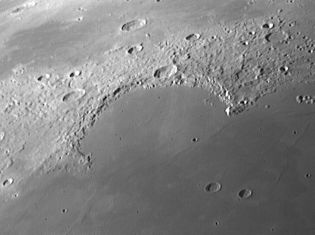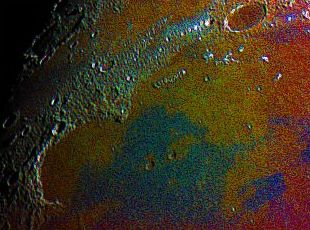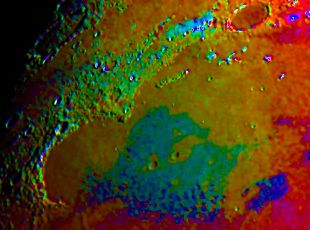There are almost as many reasons for doing astrophotography as there are astrophotographers—all of them valid. My own purpose has always been to show objects as close as possible to how they really are. This is why I dislike the Hubble palette for narrow-band images of emission nebulae. Hydrogen is the most common element in the universe and so emission nebulae shine predominantly in the red. They must look red, but the Hubble palette puts the hydrogen emission in the green channel so they all look green, which they wouldn't if your eye was sensitive enough to see the colours. There may be excellent scientific reasons for displaying the colours in this way, but I suspect that this is not the primary reason that amateurs take astrophotographs.
As far as the Moon is concerned, I have been using a DSLR recently and have come to realise that these cameras have a non-linear response to light, and in some ways this non-linearity can improve the appearance of the Moon in a photograph. But to me it is not what the Moon is actually like, and I have gone to some trouble to linearise the response of my DSLRs which I describe elsewhere. My purpose here is to discuss the issues involved in bringing out the colour of the Moon.
It was Jim Lovell, commander of Apollo 13, who said "The Moon is essentially gray, no colour; looks like plaster of Paris or sort of a grayish beach sand". But there is colour there and others have been very successful in bringing out the subtle colours that are there. I have not. I have however dabbled with exaggerated colour in the hope that that would produce some interesting pictures emphasising different features on the Moon. It was only with the publishing of Chuck Wood's remarkable book The Modern Moon in 2003 that I became aware of the significance of colour differences in the lunar lavas. Examination of the samples brought back by the Apollo astronaughts has shown that these lavas can be divided into three basic groups depending on the concentration of Titanium and are classified as high-titanium, low-titanium, and very-low-titanium with sub-categories depending on the content of Aluminium and Potassium. This is rather different from terrestrial lavas. What is significant is that the reflectance spectra are different. There is no exact correlation but in general the high-titanium lavas reflect more of the blue light, and the low-titanium lavas reflect more of the red light. Accurate photometry can enable chemical compositions to be determined on parts of the Moon far from where the astronauts landed. The high-titanium lavas are also slightly darker than the low-titanium ones and this can be seen in both infra-red and visible wavelengths.
All my photographs prior to 2010 were made with the Philips ToUcam 740, and I made the saturated-colour images by using a photo-manipulation programme to increase the colour saturation to 100%. (I use a very old programme called PhotoImpact which I obtained packaged with a scanner, but I am sure any similar programme will do the same thing.) This produced vivid colours that showed the differences well. There are several examples on this site, for example here and here.

 When my ToUcam 740 failed in 2010, I replaced it with a DFK 21AF04 from the Imaging Source but did not continue with producing saturated-colour images. However, more recently I decided I wanted to repeat the observation I made of the lavas in this picture (left) of Sinus Iridum with a colour picture on the same scale. This picture was taken in infra-red light and clearly shows a difference in albedo of the lavas bisecting Sinus Iridum. (If you can't see this in the small image to the left see the full-sized image.) The colour image made at the time (see here) was at a much smaller scale, but shows a difference in colour very clearly. I wanted to show the effect at the same scale as the IR image. I tried three different cameras, the DFK, a DSLR, and a ToUcam 840. On the right here, is a picture taken with the DFK camera with its colour saturation increased to 100%. The difference in colour is there but by no means as clearly as I obtained with the ToUcam 740. The results from the DSLR and the 840 were similarly disappointing. I examined, mainly, the DFK image in various ways to try to work out why there was so much difference. The conclusion seems to be that the differentiation of colour by the various colour chips is quite different, caused presumably by the colour filters on the chips themselves. There is some evidence of a greater noise level in the colour rendering of the DFK over the ToUcam but more frames had been stacked for the DFK image than had been for the ToUcam.
When my ToUcam 740 failed in 2010, I replaced it with a DFK 21AF04 from the Imaging Source but did not continue with producing saturated-colour images. However, more recently I decided I wanted to repeat the observation I made of the lavas in this picture (left) of Sinus Iridum with a colour picture on the same scale. This picture was taken in infra-red light and clearly shows a difference in albedo of the lavas bisecting Sinus Iridum. (If you can't see this in the small image to the left see the full-sized image.) The colour image made at the time (see here) was at a much smaller scale, but shows a difference in colour very clearly. I wanted to show the effect at the same scale as the IR image. I tried three different cameras, the DFK, a DSLR, and a ToUcam 840. On the right here, is a picture taken with the DFK camera with its colour saturation increased to 100%. The difference in colour is there but by no means as clearly as I obtained with the ToUcam 740. The results from the DSLR and the 840 were similarly disappointing. I examined, mainly, the DFK image in various ways to try to work out why there was so much difference. The conclusion seems to be that the differentiation of colour by the various colour chips is quite different, caused presumably by the colour filters on the chips themselves. There is some evidence of a greater noise level in the colour rendering of the DFK over the ToUcam but more frames had been stacked for the DFK image than had been for the ToUcam.

For my final image as of July 2021 I tried a different approach. Having made my colour image using the DFK camera and stacking 612 frames I increased the colour saturation to 100% in PhotoImpact giving me the image shown on the right above. I applied a Gaussian blur with a variance of 5 and used that as a colour layer over the original picture in Photoshop. The resulting colour image was rather dull but I found that I could increase the saturation again in PhotoImpact and at 100% the picture is shown on the right here. I thought that this overdid it somewhat, so I reduced the saturation to 50% for the mouseover picture here on my Sinus Iridum page. Still not as good as my ToUcam images but at least it shows the different colours in a way that determines that the east of the main dividing line are of the low-titanium type and the lava to the west is of the high-titanium type. The division within Sinus Iridum itself does not show up—I don't know why. Also I think that the southern edge of the picture should not be red. If you compare it with the ToUcam picture you will see that the whole of the western part was coloured blue. It seems likely that all the lavas on Oceanus Procellarum would be of the same type and that these cover the western part of Mare Imbrium. Whether they flowed over the low-titanium lavas from the east or the other way round is uncertain.
Further investigations may follow....
Home Back to the Moon